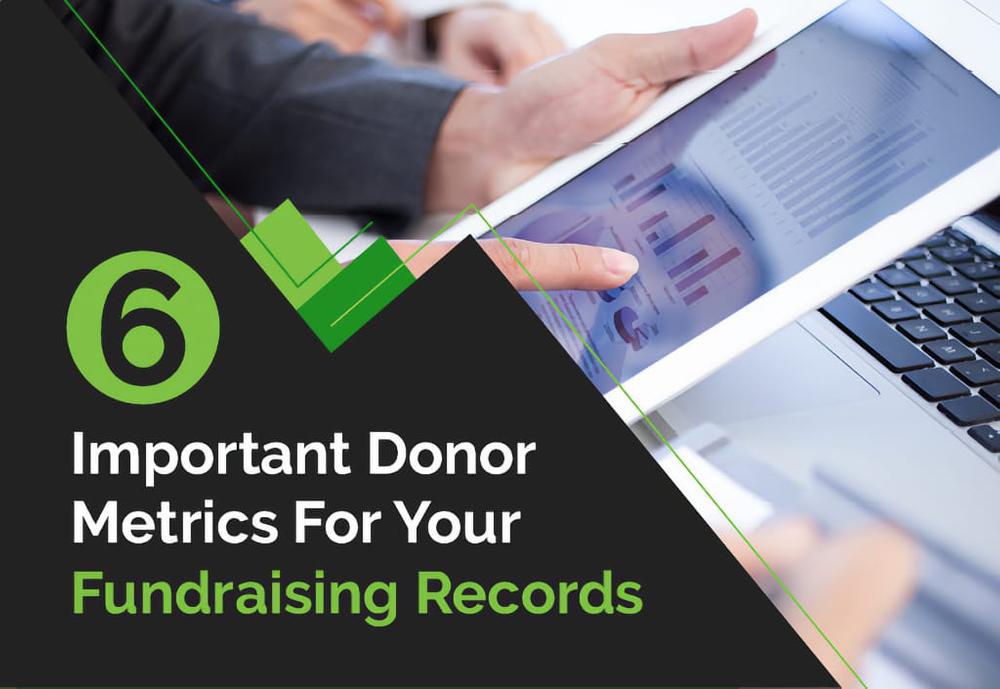Your nonprofit’s fundraising initiatives are essential for advancing your mission. In order to optimize your strategy for the most impactful results, you’ll need to leverage data. The right donor metrics can take your nonprofit’s fundraising and donor engagement efforts to the next level, allowing you to track progress toward your goals and identify areas for future improvement.
Devote some time to your nonprofit’s data hygiene by erasing duplicate information, removing lapsed donors, and refining how your donor database is organized. Then, it’s time to define relevant metrics for strategic data collection and analysis moving forward.
Make the most of your organization’s fundraising by keeping an eye on these crucial donor metrics:
- Website Traffic and Conversions
- Outreach Results
- Donor Retention Rate
- Wealth Indicators
- Event Participation and Engagement
- Donor Networks
CharityEngine’s rundown of popular nonprofit CRMs emphasizes choosing software that facilitates reporting and data analytics for your organization. Implementing an effective data collection strategy will drive your nonprofit to new fundraising heights, so let’s dive right in.

1. Website Traffic and Conversions
Every successful donor relationship begins with their exposure and awareness of your nonprofit’s work. Using your CMS or analytics tools, track metrics on your website to determine how people find and interact with your content.
This data can yield insights for your marketing strategy and goals. For instance, you may discover that your nonprofit’s online auction drives significant traffic to your donation page. With website engagement metrics, your organization will be able to learn:
- How easily people can find your organization online. If your website has ranking content and can easily be found through organic traffic, this means that potential supporters have higher chances of interacting with your nonprofit. Otherwise, you may need to look into some search engine optimization (SEO) tools to improve your site’s visibility.
- Bounce rates for your fundraising pages. If people tend to bounce from your campaign pages, this may indicate a need to optimize your content to streamline the giving process.
- The geographic locations of website visitors. If you notice a significant number of donors and prospects outside your local area, you may benefit by adjusting your strategy to appeal to them. For instance, hosting a virtual or hybrid event rather than an in-person one may better engage these supporters.
To better leverage search engines and help potential donors find your organization, consider implementing SEO strategies and applying for the Google Ad Grant. Your website is a significant resource for people to learn more about your nonprofit and get inspired to give, so having web pages that encourage engagement is essential—whether you’re launching a new campaign or preparing for year-end giving.

2. Outreach Results
Attracting and engaging new supporters is vital to your nonprofit’s long-term fundraising success. Set relevant metrics to measure the effectiveness of your outreach strategy to determine how best to tailor your marketing efforts.
To gauge how well your organization’s outreach resonates with prospective donors, look at metrics such as:
- Email open and click-through rates
- New social media follows
- Social media conversion rates
When soliciting donations from current supporters, boost your results by personalizing your outreach with each individual’s name and relevant information. Incorporate eye-catching calls to action and feature your organization’s logo and colors throughout your communications.

3. Donor Retention Rate
Ultimately, it’s much more efficient for your nonprofit to retain existing donors than to constantly acquire new ones. It costs much more to attract fresh support to power your mission, so ensure that your organization is dedicating time and resources to achieve a healthy donor retention rate.
To calculate your donor retention rate, take your number of current donors who gave last year and divide them by the total number of donors who gave last year. Multiply by 100 to get the percentage. According to the Fundraising Effectiveness Project, the average nonprofit donor retention in 2022 was 29.9%.
By leveraging your donor management to its fullest extent, your nonprofit can steward each donor and increase their lifetime value. Apply these best practices to your donor engagement strategy:
- Offer a recurring donation option on your donation page.
- Personalize your outreach based on supporters’ interests.
- Provide additional engagement opportunities, such as peer-to-peer fundraising and volunteering.
- Thank your donors regularly.
Nurture your donors’ investment in your cause for the long run by showing that you value their contributions. Sending out surveys to supporters can be a valuable way to gather feedback for improving your donor engagement over time.

4. Wealth Indicators
Wealth indicators are important donor metrics for optimizing your nonprofit’s donation requests and ensuring that you’re asking appropriate amounts from your supporters. This is especially important for major fundraising initiatives such as capital campaigns, where you need to develop a detailed gift range chart.
Before you make your asks, examine donor profiles for information such as their average donation amount and giving frequency. Additionally, NPOInfo recommends conducting a wealth screening to guide your prospect research for mid-level and major gifts.
Look for notable wealth markers such as:
- Stock ownership
- Real estate ownership
- Political giving
- Net income
This data can provide crucial insight regarding each prospective donor’s capacity to give, allowing you to strategically adjust your nonprofit’s solicitations.

5. Event Participation and Engagement
Your nonprofit’s events are fundamental opportunities to engage supporters and encourage them to donate to your mission. Therefore, it’s critical to track event-related metrics to identify ways to enhance your results and make each fundraising event more productive than the last. For instance, for each event, be sure to collect data on:
- Attendance
- Additional donations collected
- Volunteer hours
- Event format, whether in-person, hybrid, or virtual
- Associated peer-to-peer campaigns
Comprehensive event reports can reveal how successful your organization’s promotional and planning efforts were. If any adjustments need to be made, you can incorporate this into your next event plan for even greater results. Additionally, include these metrics in your supporter profiles so that you can tailor your follow-ups and thank-yous to attendees after the event.

6. Donor Networks
Each of your supporters has their own personal network of friends, family, and acquaintances that can be valuable for extending your nonprofit’s reach. By gathering information on your donors’ existing connections, you can direct your outreach to cultivate new support for your mission.
Build out your donor profiles to include:
- Friends and family. Your donors often share similar interests and values with those who are closest to them. Find out what motivates them to support your nonprofit and use this information to appeal to their personal networks to improve your donor acquisition.
- Employers. Your supporters’ employers may offer matching gift programs that could increase the impact of their gifts. Additionally, you may be able to identify local business owners that may be receptive to sponsoring your future fundraising events.
- Commonalities with other supporters. By pinpointing commonalities among your current supporters, you may be able to discover new sources of potential donors. For instance, if a large proportion of your nonprofit’s supporters attended a particular college, you can appeal to others affiliated with that college to get involved.
By keeping track of your donors’ connections, you can find ways to leverage them for more effective outreach efforts to increase your organization’s support.
As your nonprofit expands and makes progress toward its goals, take advantage of opportunities for additional growth by keeping track of donor metrics along the way. This data is not only beneficial for discovering areas to improve your fundraising efforts, but also useful for reporting your organization’s success. Donors want to know that their contributions are making a difference in furthering your mission, so keep them regularly updated on your successes and upcoming initiatives to maximize their investment in your nonprofit.




